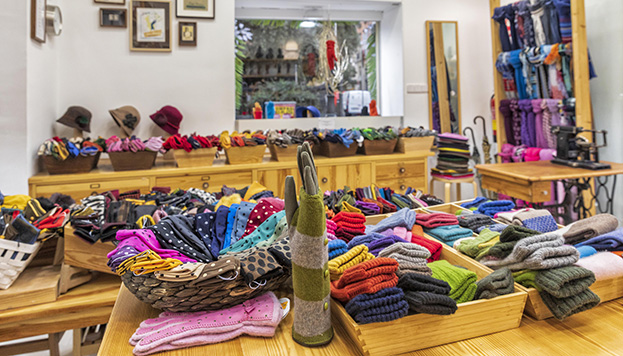A tailor-made glove
Not only is it the most elegant of all fashion accessories, but it also protects our hands from the cold. Our city can boast numerous shops and workshops where their gloves are still 100% handmade. The result? Pairs of gloves that last a lifetime.

Although the Barbarians in northern Europe used gloves to help them fight the cold, in other cultures they quickly became a symbol of nobility. In Ancient Egypt, only priests and the Pharaoh himself were allowed to wear them: embroidered linen gloves were found in the tomb of Tutankhamun, no less. In the Persian court, no one dared appear before the king unless they were wearing them, while in the Middle Ages they were an indispensable feature of feudal investitures. It was not until the Renaissance that they took on a purely ornamental function, sometimes bathed in evocative essences such as violet, for example.
Huertas, 1. Metro: Sevilla
In the same building in which Francisco de Rojas Zorrilla, a 17th century playwright from the school of Calderón, once lived and died, the doors of one of those shops that are part and parcel of the living history of our city are wide open. Today, another Francisco, Guzmán in this case, runs this business which was founded in 1896 in Calle Carretas, very close to its current address, in the heart of the Barrio de las Letras (the Literary Quarter). It went by a different name at that time, Guantes Zurro or Zurro Gloves. The manager of the factory married the owner's daughter and kept up the tradition of making this garment. His radio ad back then had this to say: ‘Mario Herrero, the best glove maker in the entire world’. His fame grew over the decades and he set the standard at a time when gloves were used to add a dash of sophistication to suits and dresses.

We can learn about all these and many other interesting things at Santacana, which is still making one hundred percent handmade gloves at its factory in Humanes, Madrid. They use traditional tools, such as the implement used to measure glove length in French inches, a blunt knife used to abrade the gloves, the chalk used to mark out the size of the leather, and hand forms, as well as several other indispensable tools. As is the case here, it is also important to work with the best tanners in the world. The leather is selected individually to match the desired shade. To achieve the perfect finish, the sewing is done both manually and with specialized machines.

‘We love craftsmanship’. That could well be Santacana's slogan. Although sustainability, local knowledge and respect for materials are their main hallmarks, they are well aware here that all this is not at odds with modern times, which have opened up a new world of creativity. Accordingly, since the 1970s it has been possible to purchase not only leather garments in their beautiful boutique, but also knitted ones, such as their fancy polka-dotted gloves or coloured mittens, always a firm favourite with the public. If you’re not sure which model to choose from the catalogue, don't worry, the staff behind the counter are on hand to give out good advice.

Espoz y Mina, 3. Metro: Sol
Just a few steps away, next to the Puerta del Sol, there is another hundred-year-old shop with a history that goes all the way back to 1886. That was the year in which it opened its doors in the square itself, before moving to its current location in 1927. Álvaro Ruiz, its current owner, is a member of the fourth generation of glove makers who founded this shop, where it seems that time has stood still. Its cash register, the mirrors, the counter... everything has remained the same since the mid-1950s. Perhaps the most striking thing here, though, is the logo itself, which depicts two dogs fighting over a glove. It is a true work of art signed by Enrique Herreros, a humourist and illustrator, director of the legendary magazine La Codorniz, and author of many of the posters that, in his day, advertised film premieres on Gran Vía.

A Gran Vía on which, in its golden age, no one would have dared to promenade without gloves. The gloves made by the Luque family were, and still are, totally handmade and hand-stitched, as dictated by the tradition of a trade that has well-nigh disappeared. Without a doubt, they are the most elegant fashion accessory. Many stylists come here to find a perfect pair to enhance their look or to find a pair that is just right for the wardrobe of a film — some even made in Hollywood — or a series, such as Velvet. A fact for the curious: in the 1930s, all the contenders for the Miss Spain contest wore Luque gloves.

Amid all the sewing machines and the hand dummies, customers can choose from an infinite number of models, made of satin, suede, silk... and all the styles one can imagine, for both classic and modern clients, with a little bit of bling if necessary. The best sellers? Black leather gloves, for both men and women. You shouldn't leave without trying them on, the experience is worth it. The counters have small cushions to support the elbow and to let you stretch out your hand better. Special sticks are also used to widen them if necessary. The best always comes last: Luque's gloves last a lifetime and never go out of style!

